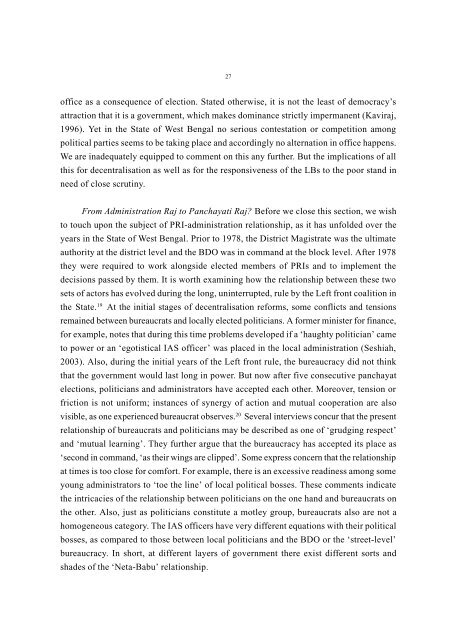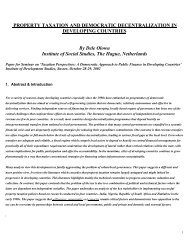View Article - Institute of Development Studies
View Article - Institute of Development Studies
View Article - Institute of Development Studies
Create successful ePaper yourself
Turn your PDF publications into a flip-book with our unique Google optimized e-Paper software.
27<strong>of</strong>fice as a consequence <strong>of</strong> election. Stated otherwise, it is not the least <strong>of</strong> democracy’sattraction that it is a government, which makes dominance strictly impermanent (Kaviraj,1996). Yet in the State <strong>of</strong> West Bengal no serious contestation or competition amongpolitical parties seems to be taking place and accordingly no alternation in <strong>of</strong>fice happens.We are inadequately equipped to comment on this any further. But the implications <strong>of</strong> allthis for decentralisation as well as for the responsiveness <strong>of</strong> the LBs to the poor stand inneed <strong>of</strong> close scrutiny.From Administration Raj to Panchayati Raj? Before we close this section, we wishto touch upon the subject <strong>of</strong> PRI-administration relationship, as it has unfolded over theyears in the State <strong>of</strong> West Bengal. Prior to 1978, the District Magistrate was the ultimateauthority at the district level and the BDO was in command at the block level. After 1978they were required to work alongside elected members <strong>of</strong> PRIs and to implement thedecisions passed by them. It is worth examining how the relationship between these twosets <strong>of</strong> actors has evolved during the long, uninterrupted, rule by the Left front coalition inthe State. 19 At the initial stages <strong>of</strong> decentralisation reforms, some conflicts and tensionsremained between bureaucrats and locally elected politicians. A former minister for finance,for example, notes that during this time problems developed if a ‘haughty politician’ cameto power or an ‘egotistical IAS <strong>of</strong>ficer’ was placed in the local administration (Seshiah,2003). Also, during the initial years <strong>of</strong> the Left front rule, the bureaucracy did not thinkthat the government would last long in power. But now after five consecutive panchayatelections, politicians and administrators have accepted each other. Moreover, tension orfriction is not uniform; instances <strong>of</strong> synergy <strong>of</strong> action and mutual cooperation are alsovisible, as one experienced bureaucrat observes. 20 Several interviews concur that the presentrelationship <strong>of</strong> bureaucrats and politicians may be described as one <strong>of</strong> ‘grudging respect’and ‘mutual learning’. They further argue that the bureaucracy has accepted its place as‘second in command, ‘as their wings are clipped’. Some express concern that the relationshipat times is too close for comfort. For example, there is an excessive readiness among someyoung administrators to ‘toe the line’ <strong>of</strong> local political bosses. These comments indicatethe intricacies <strong>of</strong> the relationship between politicians on the one hand and bureaucrats onthe other. Also, just as politicians constitute a motley group, bureaucrats also are not ahomogeneous category. The IAS <strong>of</strong>ficers have very different equations with their politicalbosses, as compared to those between local politicians and the BDO or the ‘street-level’bureaucracy. In short, at different layers <strong>of</strong> government there exist different sorts andshades <strong>of</strong> the ‘Neta-Babu’ relationship.





